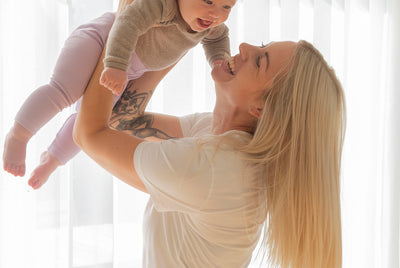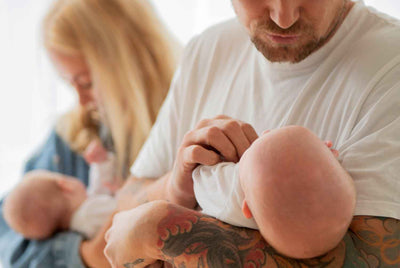It is important that you have as much control over your baby's sleeping positions as you do over sleep routines, sleep needs and sleep cycles. In the worst case, the wrong sleeping position can cause cot death. In addition, the crooked positions in the baby bed, the pram and the baby nest can lead to a flat back of the head or a crooked head shape.
Correlation between sleeping positions and risk of SIDS
Today, there are virtually no cases of cot death in our country, and this is due to the great focus that has been on the risk factors over the past 2 decades. Among the most dominant and influential factors affecting the risk of cot death is the sleeping position in which the baby lies on its stomach.
In this position, the vulnerable airways, which have not yet been made strong, are exposed to great strain from the baby's weight.
Another factor that can also have an influence on increasing the risk of the baby dying in connection with sleep is elevated body temperature.
Today, it is part of health care providers' guidance for new parent couples that:
- The baby should always be put to sleep on its back
- The baby must be ensured an optimal body temperature (both before and during sleep).
Where 15 years ago around 110 deaths in babies were recorded due to incorrect sleeping positions and an unfavorable sleeping environment, there are around 10 cot death related deaths today.
What do I do if my baby turns over on his stomach in his sleep?
Should it happen that your baby turns over on its stomach in its sleep, it is ok to let the baby continue to sleep in this position. In principle, your baby must sleep in the position or positions that occur once he or she has fallen asleep. The only time your baby should fall asleep on your stomach is when he or she is lying on you and you are awake.
As well as paying attention to the baby's sleeping position, you also have to pay attention to the body temperature. A good way to find out if your baby is too hot is to feel the chest.
Here your baby gets the safest sleeping positions
The bed and the physical surroundings have a great influence on which sleeping positions your baby has, and this has an influence on the quality of sleep. The best place for your little son or daughter is to lie in his own bed next to the parent's bed.
It can be tempting to let the baby sleep between you. When we sleep, we do not have full control over our body movements, and this can both disturb the small child and create dangerous situations.
If it is desired to let the baby sleep in the parent's bed, the child must lie next to both of you. This means that mother and father will lie close to each other, and the baby will lie between one of the parents and the cot.
Especially about avoiding the development of a crooked head shape and flat back of the head
The baby's head is soft and it is malleable in the first 12 months after birth. The baby's lying position will have an influence on how the head shape will be. If the baby lies a lot on its back without special support for the neck, it can create a flat back of the head.
When you and the baby are awake, it is a good idea to let the baby lie on the stomach. This helps to train the important neck muscles, and it makes the child strong and mobile for the rest of his life.
When the baby is resting or sleeping on its back, it is a good idea to ensure that the head is turned to both sides (so that the baby is not only lying with its head facing the ceiling or sky).
When you play and babble with your baby on the activity mat or on the sofa, you can advantageously make games where the baby has to turn its head. This stimulates the baby to become more flexible in its sleeping position, and it strengthens gross motor skills and flexibility in the body.
Worth knowing about babies' neck muscles
For us adults, it may immediately sound uncomfortable to have to lie on your back and have your head turned either completely to the right or completely to the left.
What is special about this situation is that the baby's soft neck is mobile and flexible. It is therefore generally not associated with pain or discomfort to have the recommended sleeping position of lying on your back and resting your head alternately on both sides.
Not all babies find it easy to rest and sleep on their backs. Digestive problems can cause physical discomfort when lying on the back. And any locking in the neck muscles can make the sleeping position difficult.
It is recommended that you contact your healthcare provider if you experience challenges in getting your son or daughter to sleep on their back over a longer period of time.
Reflux disease - therefore sleeping on the back can be challenging
Some babies are diagnosed with reflux, which is a disease related to the sphincter muscle that sits at the front of the esophagus and close to the stomach. It is completely normal for babies to burp a little after meals. The sphincter is not fully developed, and therefore some food or milk can get back up through the oesophagus.
Reflux disease is a condition where swallowing is associated with discomfort in the baby. Here, it is not only milk that is directed up through the esophagus but also stomach acid. It can reduce the baby's well-being, ruin sleep and create more or less permanent discomfort when acid-containing contents come up from the stomach at regular intervals.
If your baby has reflux disease, it is a good idea to raise the headboard of the baby bed a little, so that gravity helps to prevent acid from coming up when the baby sleeps on its back.
Good advice to avoid a flat back of the head and a crooked head shape
-
If you give your baby a bottle, you must switch arms each time the baby is fed.
-
Place a stuffed animal in the pram or baby bed that will remind you which direction the baby's head was the last time he slept or napped.
-
Pay attention to whether your baby has a locked neck or a stomach ache as the reason why he or she has difficulty sleeping on his or her back.
-
Contact your healthcare provider if your baby does not feel comfortable sleeping on its back.
-
Consider using a raised headboard in the cot if your baby has reflux disease.



